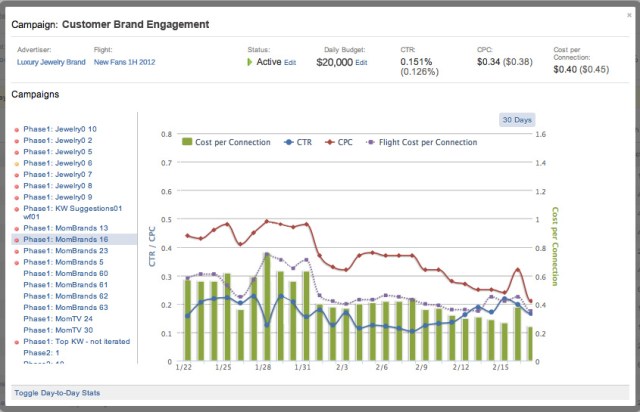
Whenever I hear brands talking about advertising on social networks, one of the most common questions is, “Well, what’s the actual return?” Now a startup called GraphScience says it has turned measuring and optimizing that return into, well, a science.
The company is officially launching today, but it’s one of those startups that has been in stealth mode for a ridiculously long period of time. GraphScience was founded in 2010, and launched many of its services in 2011. And the company already counts jewelry site Ice and fashion site HauteLook among its customers.
GraphScience’s SocialEngine technology taps into the Facebook ads API. SocialEngine was originally built as an engine to drive e-commerce. Whether a purchase happens in a Facebook store or on a business’ website, SocialEngine can tell if it was prompted by a Facebook ad, and it makes recommendations on which Facebook users should be target to drive the most purchases.
For example, founder and CEO Raymond Rouf said GraphScience found certain ads would do well if they were directed at Facebook users who “liked” the Bible — in fact, the ads were similarly effective if they were targeted at people who liked other holy books like the Koran. (Yes, it felt a little weird to be talking about the relative conversion rates of the Bible and the Koran.)
Earlier this month, Bloomberg reported on the closure of Facebook stores from retailers like Gamestop and J.C. Penny. Most memorably, it quoted Forrester analyst Suchin Mulpuru as saying that Facebook commerce didn’t work, because it was “like trying to sell stuff to people while they’re hanging out with their friends at the bar.” When I asked Rouf about the Bloomberg story, and he countered that failing stores were “lackadaisical efforts that were not being strategic about what will work and what won’t.”
And yes, there are other systems for monitoring and targeting Facebook ads, but Rouf argued that most of them come from search companies who ported their services over to social — unlike GraphScience, which he says was designed specifically for Facebook.
As for GraphScience’s customers, the company says its customers saw an average 4-8x increase in their return on investment (ROI) from their Facebook ads. And while its initial focus was e-commerce, GraphScience expanding beyond that to serve more traditional consumer packaged goods companies and other advertisers. A laundry detergent company, for example, might not care about selling detergent from its website. Nonetheless, GraphScience can provide valuable data about who’s looking at and engaging with its ads, which in turn helps the company understand whether those ads are paying off.
Source:http://techcrunch.com/2012/02/28/graphscience-socialengine-launch/
The company is officially launching today, but it’s one of those startups that has been in stealth mode for a ridiculously long period of time. GraphScience was founded in 2010, and launched many of its services in 2011. And the company already counts jewelry site Ice and fashion site HauteLook among its customers.
GraphScience’s SocialEngine technology taps into the Facebook ads API. SocialEngine was originally built as an engine to drive e-commerce. Whether a purchase happens in a Facebook store or on a business’ website, SocialEngine can tell if it was prompted by a Facebook ad, and it makes recommendations on which Facebook users should be target to drive the most purchases.
For example, founder and CEO Raymond Rouf said GraphScience found certain ads would do well if they were directed at Facebook users who “liked” the Bible — in fact, the ads were similarly effective if they were targeted at people who liked other holy books like the Koran. (Yes, it felt a little weird to be talking about the relative conversion rates of the Bible and the Koran.)
Earlier this month, Bloomberg reported on the closure of Facebook stores from retailers like Gamestop and J.C. Penny. Most memorably, it quoted Forrester analyst Suchin Mulpuru as saying that Facebook commerce didn’t work, because it was “like trying to sell stuff to people while they’re hanging out with their friends at the bar.” When I asked Rouf about the Bloomberg story, and he countered that failing stores were “lackadaisical efforts that were not being strategic about what will work and what won’t.”
And yes, there are other systems for monitoring and targeting Facebook ads, but Rouf argued that most of them come from search companies who ported their services over to social — unlike GraphScience, which he says was designed specifically for Facebook.
As for GraphScience’s customers, the company says its customers saw an average 4-8x increase in their return on investment (ROI) from their Facebook ads. And while its initial focus was e-commerce, GraphScience expanding beyond that to serve more traditional consumer packaged goods companies and other advertisers. A laundry detergent company, for example, might not care about selling detergent from its website. Nonetheless, GraphScience can provide valuable data about who’s looking at and engaging with its ads, which in turn helps the company understand whether those ads are paying off.
Source:http://techcrunch.com/2012/02/28/graphscience-socialengine-launch/

No comments:
Post a Comment